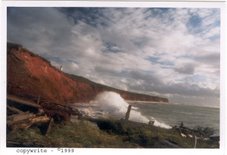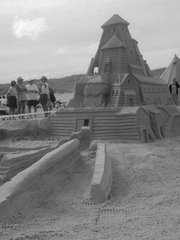The Common Sand Dollar (Echinarachnius parma)
The beaches of the Magdalen Islands are littered with shell of all types. One of the most treasured shells found is the sand dollar. The fragile disk is the skeleto n or "test" of a marine animal. By the time the test washes up on the beach, it is missing its velvety covering of minute spines and appears somewhat bleached from the sun.
n or "test" of a marine animal. By the time the test washes up on the beach, it is missing its velvety covering of minute spines and appears somewhat bleached from the sun.
Sand dollars are from the class of marine animals known as Echinoids, spiny skinned creatures. Their relations include the sea lily, the sea cucumber, the star fish and the sea urchin. When alive, the sand dollar is outfitted in a maroon-colored suit of movable spines that encompass the entire shell. Like its close relative the sea urchin, the sand dollar has five sets of pores arranged petal pattern. The pores are used to move sea water into its internal water-vascular system which allows for movement.
Sand dollars live beyond mean low water on top of or just beneath the surface of sandy or muddy areas. The spines on the somewhat flattened underside of the animal allow it to burrow or to slowly creep through the sand. Fine, hair-like cilia cover the tiny spines. These cilia, in combination with a mucous coating, move food to the mouth opening which is in the center of the star shaped grooves on the underside of the animal. Its food consists of plankters and organic particles that end up in the sandy bottom.
Because of their small size and relatively hard skeleton, few animals bother sand dollars. One animal found to enjoy them on occasion is the thick-lipped, eel-like ocean pout, snails, sea stars (starfish) and skates (rays).
The Sand Dollar
 n or "test" of a marine animal. By the time the test washes up on the beach, it is missing its velvety covering of minute spines and appears somewhat bleached from the sun.
n or "test" of a marine animal. By the time the test washes up on the beach, it is missing its velvety covering of minute spines and appears somewhat bleached from the sun.Sand dollars are from the class of marine animals known as Echinoids, spiny skinned creatures. Their relations include the sea lily, the sea cucumber, the star fish and the sea urchin. When alive, the sand dollar is outfitted in a maroon-colored suit of movable spines that encompass the entire shell. Like its close relative the sea urchin, the sand dollar has five sets of pores arranged petal pattern. The pores are used to move sea water into its internal water-vascular system which allows for movement.
Sand dollars live beyond mean low water on top of or just beneath the surface of sandy or muddy areas. The spines on the somewhat flattened underside of the animal allow it to burrow or to slowly creep through the sand. Fine, hair-like cilia cover the tiny spines. These cilia, in combination with a mucous coating, move food to the mouth opening which is in the center of the star shaped grooves on the underside of the animal. Its food consists of plankters and organic particles that end up in the sandy bottom.
Because of their small size and relatively hard skeleton, few animals bother sand dollars. One animal found to enjoy them on occasion is the thick-lipped, eel-like ocean pout, snails, sea stars (starfish) and skates (rays).
On the ocean floor, sand dollars are frequently found together. This is due in part to their preference of soft bottom areas, as well as convenience for reproduction. The sexes are separate and gametes are released into the water column as in most echinoids. The free-swimming larvae metamorphose through several stages before the test begins to form and they become bottom dwellers.
Since the sand dollar lives in sandy locations, anyone who would like to collect their shells should comb beaches as the tide recedes. The very best time for collecting is after a heavy storm, as many of the shells that have died are dredged up by the increased wave action. Some say that sand dollars are pressed sand that has been dried or even the money of mermaids washed-up from the deep.The Sand Dollar

About the life of Jesus and the wondrous tale of old.
The center marking plainly shows,
The well known guiding star
That led to tiny "Bethlehem"
The wise men from afar.
The Christmas flower poinsettia,
For his nativity, the resurrection
Too is marked, The Easter Lily, see.
Five wounds were suffered by our Lord,
From nails and roman spears
When he died for us upon the cross,
The wounds show plainly here.
Within the shell should it be broke,
Five doves of peace are found
To emphasize this legend
So may peace and love abound.





2 comments:
That's an awesome place you live in. Is there more space for one more family to build themselves a house? :)
Hey Buddy. Long time since ive been here. Love the Sand Dollar Poem and of cours the picture. Very disturbing to me that my blog is only worth 5 loonies and yours is worth thousands. Have an awesome day. Deirdre
Post a Comment